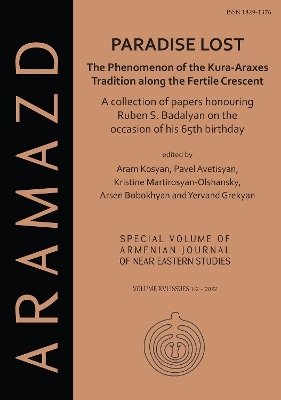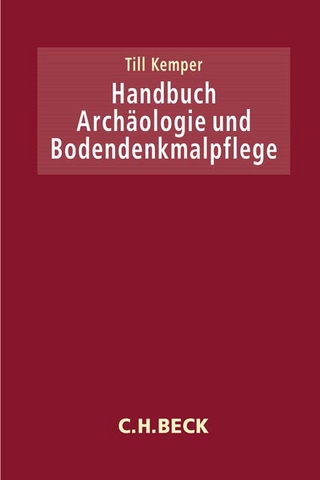
Paradise Lost: The Phenomenon of the Kura-Araxes Tradition along the Fertile Crescent
Archaeopress Archaeology (Verlag)
978-1-80327-448-5 (ISBN)
Pavel Avetisyan is a former student of Gregory Areshian during his study at the Yerevan State University in 1975-1980; he now leads together with Gregory and Kristine Martirosyan-Olshansky the joint Armenian-American archaeological team at the excavations of the Neolithic settlement at Masis Blur, Armenia. Pavel received his PhD in 2003 (Chronology and Periodization of the Middle Bronze Age of Armenia) and D.Sc. in 2014 (Armenian Highland during the 24-9th centuries BC. The Dynamics of Socio-Cultural Transformations, according to Archaeological Data). His areas of research are Old World archaeology and the Neolithic and Iron Age cultures of Transcaucasia, devoting his studies also to the periodizations and chronology of the Bronze and Iron Ages of Transcaucasia. Professor Avetisyan is the Director of the Institute of Archaeology and Ethnography, National Academy of Sciences of Armenia and Professor at the Yerevan State University. Arsen Bobokhyan, PhD in Archaeology, is a Director and Leading Researcher at the Institute of Archaeology and Ethnography, NAS RA. He specializes in the Bronze and Iron Age archaeology of the Armenian Highlands and the Near East, focusing in particular on ancient cults and cultural contacts. Bobokhyan currently leads excavations on Mt. Aragats and the eastern shores of Lake Sevan in Armenia. He is a co-founder and a vice-editor of the journal Aramazd. Yervand Grekyan, PhD in History, Dr. habil. is a Leading Researcher and Research Professor at the Institute of Archaeology and Ethnography and the Institute of Oriental Studies, National Academy of Sciences of Armenia (NAS RA). His research focuses on the history and culture of the Armenian Highlands from the second to the first millennia BC. He is a co-founder and a vice-editor of the journal Aramazd.
Foreword ;
Seal and sealing in the Kura-Araxes culture: New findings from northwestern Iran – Akbar Abedi ;
The Kura-Araxes tombs in Shirak region, Armenia – Levon Aghikyan ;
Homo mobilis: Some observations on the characteristics of the Kura-Araxes cultural complex – Pavel Avetisyan ;
Feminine figurine of Shengavit and its parallels – Anna Azizyan ;
The spatial Matryoshka doll: New perspectives on the settlement dynamic of the Kura-Araxes – Stephen Batiuk ;
Vertical use of space in Ancient Armenia and the case of Kura-Araxes tradition – Arsen Bobokhyan ;
The settlement of Norabats – Seda Devejyan and Ruben Davtyan ;
Materials from excavations of Fioletovo – Aram Gevorgyan and Anna Azizyan ;
Twenty years of Kura-Araxes research at Tel Bet Yerah: What we have learned – Raphael Greenberg, Mark Iserlis and Sarit Paz ;
The Kura-Araxes ‘expansion’: A climate change-related phenomenon? – Yervand Grekyan ;
The story of Karaz: A brief history of the research, and an understanding of the process of the Kura-Araxes culture in the Erzurum Highlands – Mehmet Işıklı ;
On the Kura-Araxes expansion – Aram Kosyan ;
Transformations in the Caucasus: Cultural interactions and movements of people from the Neolithic to the Early Bronze Age – Bertille Lyonnet ;
Evaluation of the Kura-Araxes migration: From a mono-factorial phantasm to a multi-dimensional phenomenon – Sepideh Maziar ;
Encountering the Kura-Araxes. Changes in the Malatya plain at the end of the 4th millennium – Giulio Palumbi and Marcella Frangipane ;
Thirty years in the making: A critical overview of the Kura-Araxes periodization from a radiocarbon perspective – Annapaola Passerini ;
Recent investigations on the Early Bronze Age sites in the Marmarik River Valley as part of the Kotayk Survey Project – Artur Petrosyan, Roberto Dan and Boris Gasparyan ;
Why deer? Figural imagery and faunal remains in the Bronze Age South Caucasus – Karen S. Rubinson ;
Zoomorphic clay figurines from the Early Bronze Age settlement of Harich – Mariam Saribekyan ;
Early Bronze Age settlement from ancient city Samshvilde – Nino Shanshashvili and Goderdzi Narimanishvili ;
New data on the construction and meaning of the Shengavit settlement wall – Hakob Simonyan and Mitchell S Rothman ;
Early Bronze Age obsidian networks: A view from Project ArAGATS – Adam T. Smith ;
On motifs and patterns on Early Trans-Caucasian IIA pottery from Yanik Tepe in northwestern Iran – Geoffrey D. Summers ;
Preliminary results of excavations of the Early Bronze Age settlement in Lernakert (Armenia) – Benik Vardanyan, Mariam Saribekyan, Ruben Davtyan, Levon Mkrtchyan and
Sona Manukyan ;
Bronze Age tomb from the cemetery of Sasunik – Nora Yengibaryan ;
Clay figurines from Agarak – Nora Yengibaryan ;
Armenian Summaries
| Erscheinungsdatum | 27.02.2023 |
|---|---|
| Reihe/Serie | ARAMAZD: Armenian Journal of Near Eastern Studies (AJNES) |
| Zusatzinfo | Illustrated in colour throughout |
| Verlagsort | Oxford |
| Sprache | englisch |
| Maße | 165 x 235 mm |
| Gewicht | 1204 g |
| Themenwelt | Geisteswissenschaften ► Archäologie |
| ISBN-10 | 1-80327-448-4 / 1803274484 |
| ISBN-13 | 978-1-80327-448-5 / 9781803274485 |
| Zustand | Neuware |
| Informationen gemäß Produktsicherheitsverordnung (GPSR) | |
| Haben Sie eine Frage zum Produkt? |
aus dem Bereich


